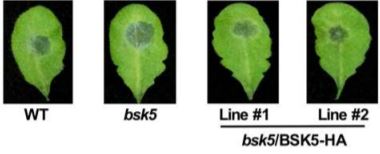A novel specialized immune player: BSK5 is required for restricting pathogen progression
Amna Mhamdi, Ghent University, Department of Plant Biotechnology and Bioinformatics, and VIB Center for Plant Systems Biology, 9052 Ghent, Belgium
Defense reactions are the fascinating result of a complex network between signals, receptors and effectors, where any missed nodes may spell disaster. At the cell surface, receptors and receptor-like kinases (RLK) recognize ligands and activate signaling pathways (Liang and Zhou, 2018). In Arabidopsis (Arabidopsis thaliana), these aforementioned proteins are encoded by several hundred genes and are able to perceive different ligands derived from intracellular and extracellular signals. For example, the pattern-recognition receptor (PRR) PEP RECEPTOR 1 (PEPR1) recognizes PLANT ELICITOR PEPTIDE (PEP) whereas ELONGATION FACTOR-TU (EF-Tu) RECEPTOR (EFR) binds the elf18 epitope of EF-Tu, and both activate pattern-triggered immunity (PTI) (Tang et al., 2017).
RLKs transduce signaling through their various interacting partners and downstream components and function in plant development and responses to hormonal and environmental cues. The signal transduction mechanisms remain a mystery, as most RLK substrates are not fully defined yet. Brassinosteroid signaling kinases (BSKs) are in vivo targets of the brassinosteroid receptor brassinosteroid insensitive1 (BRI1) and are partially redundant positive regulators of brassinosteroid signaling and brassinosteroid-dependent growth (Tang et al., 2008; Sreersmulu et al., 2013). The relevance of BSKs to plant immunity is not defined and might be diverse.
In this issue of Plant Physiology, Majhi et al. (2019) present evidence supporting the role of BSK5 in PTI. The authors show that BSK5 interacts with multiple RLKs and PRRs such as PEPR1 and EFR in a direct and specific fashion. PEPR1 and EFR phosphorylate BSK5, but not BSK1 and BSK6, thus defining BSK5 as component of signaling downstream of these PRRs. Genetic and phenotypic analyses revealed that bsk5 mutation causes increased susceptibility to both biotrophic bacteria (Pseudomonas syringae) and nectrophic fungi (Botrytis cinerea). The bsk5 mutants are also compromised in resistance to pathogens otherwise induced by PAMPs and fail to accumulate callose, reactive oxygen species and PATHOGENESIS-RELATED 1 transcripts. Majhi et al. further demonstrate that phosphorylation, kinase activity, and plasma membrane localization are essential for BSK5 immune function.
Like BSK5, BSK1 and BSK3 have been detected in protein complexes with PRRs (Shi et al., 2013; Zhang et al., 2017; Wang et al., 2017), which raises the question of how they modulate PTI differently. This difference in activity might rely on factors that determine the specificity of the association between BSKs and PRRs. Proteins that interact with BSK5 are in part different from those that interact with other BSKs; however, botrytis-induced kinase1 (BIK1) seems to act in the same signaling pathway as BSK5 and equally affects PTI-mediated responses (Liu et al., 2013). A second question relates to the specificity of BSK5 function in immunity and whether this is a ‘side’ reaction relative to its role in brassinosteroid signaling. The answer may lie in the biochemical properties of BSK5, as distinct mechanisms of activation might result in diverse physiological functions. It remains to be established how BSK5 associates with substrates to fine-tune other stress responses, and if this is a conserved mechanism that might explain bsk5 responses to salt stress and abscisic acid (Li et al., 2012). It is worth noting that the phosphorylation site of BSK5 is conserved in BSK1 and corresponds to the major site phosphorylated by the brassinosteroid receptor BRI1 (Tang et al., 2008). However, unlike in BSK5, this site is not required for BSK1 function in disease resistance (Wang et al., 2017).
Future investigation should determine how BSK5 interferes with immune signal transduction to shut down PTI responses such as the oxidative burst. In theory, this could be achieved either by direct phosphorylation of RESPIRATORY BURST HOMOLOGs or by regulating the activity of other kinases that directly influence reactive oxygen species production. Identification of BSK5 targets will shed the light on new signaling components and enhance our understanding of their activation mechanisms within and beyond Brassicaceae.
References
Li ZY, Xu ZS, He GY, Yang GX, Chen M, Li LC, Ma YZ (2012) A mutation in Arabidopsis BSK5 encoding a brassinosteroid-signaling kinase protein affects responses to salinity and abscisic acid. Biochem Biophys Res Commun 426: 522-527
Liang X, Zhou JM (2018). Receptor-like cytoplasmic kinases: central players in plant receptor kinase-mediated signaling. Annu Rev Plant Biol. 69: 267-299
Majhi BB, Sreeramulu S, Sessa G (2019). BRASSINOSTEROID-SIGNALING KINASE5 associates with immune receptors and is required for immune responses. Plant Phys. DOI: https://doi.org/10.1104/pp.18.01492
Shi H, Shen Q, Qi Y, Yan H, Nie H, Chen Y, Zhao T, Katagiri F, Tang D (2013). BR-SIGNALING KINASE1 physically associates with FLAGELLIN SENSING2 and regulates plant innate immunity in Arabidopsis. Plant Cell 25: 1100 1143-1157
Sreeramulu S, Mostizky Y, Sunitha S, Shani E, Nahum H, Salomon D, Hayun LB, Gruetter C, Rauh D, Ori N, Sessa G (2013). BSKs are partially redundant positive regulators of brassinosteroid signaling in Arabidopsis. Plant J 74: 905-919
Tang W, Kim T-W, Oses-Prieto JA, Sun Y, Deng Z, Zhu S, Wang R, Burlingame AL, Wang Z-Y (2008). BSKs mediate signal transduction from the receptor kinase BRI1 in Arabidopsis. Science 321: 557-560
Tang D, Wang G, and Zhou J-M (2017). Receptor kinases in plant-pathogen interactions: more than pattern recognition. Plant Cell 29: 618-637
Wang J, Shi H, Zhou L, Peng C, Liu D, Zhou X, Wu W, Yin J, Qin H, Ma W, He M, Li W, Wang J, Li S, and Chen X (2017) OsBSK1-2, an orthologous of AtBSK1, is Involved in rice immunity. Front Plant Sci 8: 908
Yan H, Zhao Y, Shi H, Li J, Wang Y, Tang D (2018) BRASSINOSTEROID SIGNALING KINASE1 phosphorylates MAPKKK5 to regulate immunity in Arabidopsis. Plant Physiol 176: 2991-3002
Zhang B, Wang X, Zhao Z, Wang R, Huang X, Zhu Y, Yuan L, Wang Y, Xu X, Burlingame AL, Gao Y, Sun Y, and Tang W (2016) OsBRI1 activates BR signaling by preventing binding between the TPR and kinase domains of OsBSK3 via phosphorylation. Plant Physiol 170: 1149-1161




